By EnergyNet
Published March 4, 2015
 A meeting of senior level decision-makers and investors designed to crack the transmission deadlock and open up East Africa’s power sector for investment, is set for the Kenyan capital, Nairobi, March 25-27, 2015.
A meeting of senior level decision-makers and investors designed to crack the transmission deadlock and open up East Africa’s power sector for investment, is set for the Kenyan capital, Nairobi, March 25-27, 2015.
Regionally focused, the meeting, dubbed Powering East Africa, is expected to welcome ministers, utilities and regulators from Kenya, Uganda, Tanzania, Rwanda, Ethiopia and Zambia to engage with international financiers, power developers and investors to focus on what is needed to unlock investment in transmission for regional growth and development.
Though power generation and industrialisation are expected to flow through power transmission and distribution, 4 out of 5 East Africans are currently living without access to electricity. Overall system losses in Kenya, Uganda and Tanzania are way above the global average of 10 per cent. This situation that has left the power utilities–Kenya Power, Umeme, TANESCO–grappling with spiralling operating costs that are passed on to consumers, make power more expensive in the region.
RELATED: GDP, Population and Governance Data Alone Are Not Enough to Predict Brand Success in Africa
The potential for cross border trade, increased GDPs, job creation, infrastructural development and rural electrification will energise provincial East Africa, changing lives and putting the region on the map. Without transmission, generated power will simply go to waste.
 Efficient transmission of power will allow governments in Africa to effectively utilise the power currently generated and deliver on election promises to bring electricity to rural and urban areas.
Efficient transmission of power will allow governments in Africa to effectively utilise the power currently generated and deliver on election promises to bring electricity to rural and urban areas.
It is on this premise that Ministers and senior representatives from East African countries have pledged their support in solving the region’s crippling power deficit.
During the three day-meeting key speakers are lined up to address game-changing actions for the power sector including, the critical role transmission must play in East Africa’s industrialisation, the role of power utilities, how best to overcome financing obstacles and how the cost of regional borrowing can be lessened by unlocking the transmission deadlock.
RELATED: Why Technology Shouldn’t Replace Personal Service in Travel and Tourism
The closed-meeting format of this high-level summit is designed to encourage open debate between participants and lively discussion.




